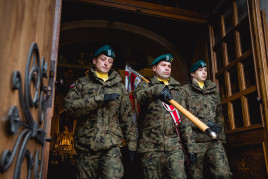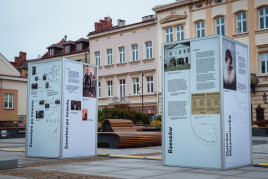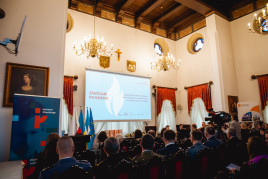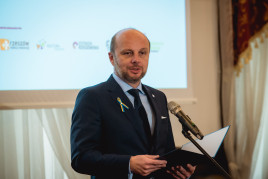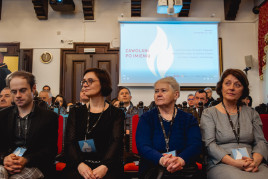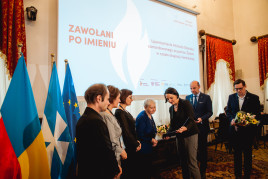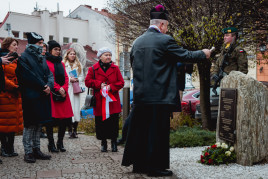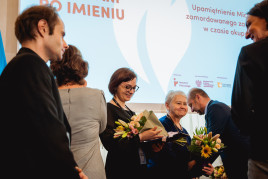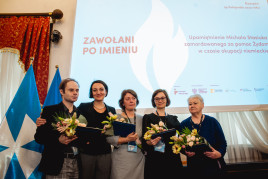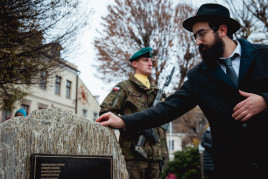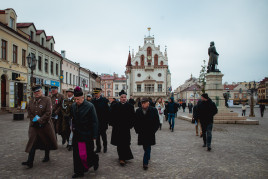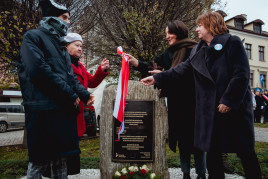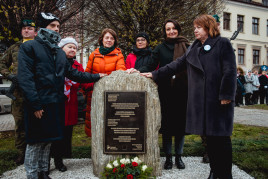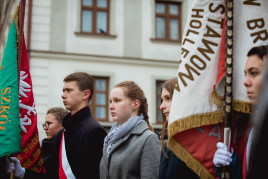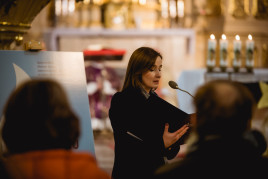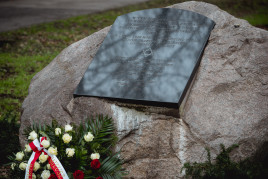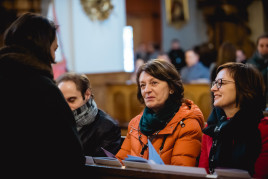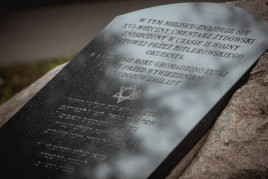The commemoration of Michał Stasiuk, Righteous Among the Nations, who was murdered for helping Jews during the German occupation | CALLED BY NAME - Instytut Pileckiego
The commemoration of Michał Stasiuk, Righteous Among the Nations, who was murdered for helping Jews during the German occupation | CALLED BY NAME
On 29 November 2022, the Pilecki Institute, together with the residents and authorities of Rzeszów, commemorated Michał Stasiuk, Righteous Among the Nations, who was murdered for helping Jews during the German occupation.
We had nowhere to go. We were worse off than homeless dogs. Some of us decided to stay with Stasiuk. Before morning we already knew that they had caught somebody from the Bunker, so that Stasiuk’s place spelt immediate danger.
Account of Lotka Golberg
On 29 November 2022 in Rzeszów, the Pilecki Institute commemorated Michał Stasiuk, who was murdered by the German functionaries for helping several dozen Jews who were hiding under the Rzeszów market square. It was the 72nd commemorated victim and the 30th ceremony as part of the “Called by Name” program, which is dedicated to those who lost their lives for helping Jews, who were earmarked for extermination, during the German occupation. The commemoration, which was organized together with the Rzeszów City Hall, was accompanied by a host of educational events prepared in cooperation with the Rzeszów Board of Education, the Rzeszów Basements and Estrada Rzeszowska.
Michał Stasiuk was born in 1890 in the village of Jakimczyce near Lwów. During World War I, he lived in Chmielnik near Rzeszów, where he and Wiktoria née Ciupak had their first son Marian, born in 1918. The family soon moved to the center of Rzeszów and initially settled in a tenement building at Króla Kazimierza Street 1. Wiktoria and Michał worked as caretakers in nearby tenement houses. Their second son, Franciszek Zygmunt, was born in Rzeszów in 1923.
Prior to the outbreak of World War II, around 40% of the inhabitants of Rzeszów were Jews, many of whom engaged in the political and cultural life of the city. The situation changed with the German occupation – in the very first months after they had taken control of Rzeszów, the Germans began a broad-scale persecution of Jews, aiming to alienate and destroy not only the city’s residents, but also thousands of deportees – mainly from Łódź and Kalisz. In late December 1941, the Germans established a ghetto, which was closed off at the beginning of the following year. In mid-1942, they resettled Jews from the neighboring towns and villages to the ghetto, increasing its population nearly twice, which further exacerbated living conditions. In early July 1942, as part of Aktion Reinhardt, the Germans began a large-scale liquidation of Jewish inhabitants by sending the majority of them to the extermination camp in Bełżec. From that point onwards the number of Rzeszów Jews was decreasing at a terrifying pace – the Germans spared mainly workers in forced labor camps. In the spring of 1943, they started killing forced laborers as well.
At that point, a group of Jews from a labor camp in Lisia Góra decided to escape and go into hiding in an attempt to save their lives. Among them were Natan Berliner from Kalisz, Bernard (Jesechiel) Kleinminc and his mother. They chose the underground area of the Rzeszów market square – a system of cellars and corridors located below the tenement buildings which had been partly demolished by the occupier. Cut off from the rest of the world, it resembled a maze full of nooks and crannies. Local Jewish tenants had been preparing the cellars in the market square area for some time, and rumors about the underground haven were circulating in the Jewish community.
The hideout dwellers named this location the “Bunker”. The number of Jews who sought refuge there kept gradually growing until it reached nearly forty people.
The Bunker was supervised by Jakub Jehoshua Springer “Sziko” from Jarosław. The tenants took turns keeping guard, established an alarm system using lights, and even organized a kitchen. Those in hiding had to somehow maintain contact with the outside world. This was done partly with the help of a Jew from Łódź by the name of Abraham Ojzerowicz. Assigned by the Germans to work as an undertaker, he was able to move around Rzeszów with relative freedom, but fearing the liquidation, at the beginning of 1944 he and his two daughters, Helena and Gusta, went into hiding in the underground area. From then on, the role of the outsider looking after the Jews in the hideout and facilitating contact with the outside world was taken up by Michał Stasiuk, whom they had met before on account of his job as a caretaker.
In 1942, the Stasiuk family lived in a tenement at the intersection of Słowackiego Street with Matejki Street, in the market square area, close to the entrance to the underground section. The Stasiuks’ house was a contact point and the place from which the Jews were smuggled into the Bunker. Involved in the aid operation was Michał’s son, Marian, who had been selected by the German labor office to work as a caretaker at the Rzeszów Gestapo headquarters. Thanks to him, the Stasiuks’ former neighbor Lejzor Torn – who had also been forced to work at the same building – managed to escape and reach the underground hideout.
The entrance to the underground complex was initially located in the corner of the market square, at Mickiewicza Street, underneath the tenement building which housed the pharmacy called “Pod Nadzieją”. It was later walled up for safety reasons, as too many people knew about its existence. This cautious approach, however, did not save the dwellers of the hideout from tragedy – in late February 1944, the laborers working nearby accidentally discovered the original entrance. The Jews panicked and rushed outside, as they assumed it was the Germans who had found the hideout. Some of the Jews headed to the only friendly place they knew – the Stasiuks’ home – but they were spotted by blue policemen. Others were immediately arrested by German gendarmes and Gestapo men. After being interrogated and tortured by Friedrich Pottebaum from the Rzeszów Gestapo, one of the female escapees revealed the details of the aid operation. All of the Jewish arrestees were murdered.
The Gestapo eventually arrested Wiktoria, Michał and Marian Stasiuk for helping Jews – a charge punishable by death under occupation law. Marian was released thanks to the fact that he worked as a caretaker at the Gestapo headquarters and that blue policemen intervened on his behalf. His mother Wiktoria was also released. Michał Stasiuk was brought before the German “special court” (Sondergericht). On 22 March 1944, posters were put up around Rzeszów, informing the public that he had been sentenced to death “for aiding elements hostile to the Reich”. Probably several days later, he was killed at the Rzeszów castle by a Gestapo executioner Alois Zieliński – a Volksdeutcher from Katowice.
The body of Michał Stasiuk was most likely buried in an unmarked grave at the Pobitno cemetery in Rzeszów. The remains of the Jews whom he was helping were transported to the Jewish cemetery in the Czekaj area and buried there. Very few of the Jews who had sought refuge in the Rzeszów cellars survived the Holocaust – among them were Natan Berliner, Lotka Goldberg and Helena Ojzerowicz.
On 19 June 2019, Yad Vashem awarded Wiktoria and Michał Stasiuk the title of “Righteous Among the Nations”.
Witness accounts
In June 1944 [probably should be 1943 – author’s note] Lejzor Torn escaped from the Gestapo and found shelter at my father’s place along with another Jewish man. Later on he was hiding in a bunker in a demolished tenement house on the same street, or rather on Mickiewicza Street, with about 10 other Jews. Their hideout was discovered by Pottebaum when its location was betrayed by one of the Jewish women who had also been hiding there. All those Jews, including Torn, were shot. Before the execution, the Jews named my father as the person who provided them with assistance. As a result, the Gestapo arrested me and my parents, and then shot my father. I was arrested only for 48 hours. I was saved by Polish policemen whose surnames I no longer remember; they testified that my father and I lived in discord. I managed to convince the Germans to spare my mother, but my father was executed.
Sworn testimony of Marian Stasiuk, 8 September 1969
Rzeszów District Commission for the Prosecution of Crimes against the Polish Nation, file ref. no. S 8/80 p. 149.
The Germans knew that the Bunker existed and searched for it. But it was camouflaged very well indeed. In the Bunker there were underground tunnels and all the time we kept on digging new tunnels so that we could escape if they were to find our hiding place. Our lives were based on discipline. Each one of us had his own duty. Watch was kept by day and night and everyone had his turn, so that we should not be surprised by the Germans. Siudek’s younger brother fixed up alarm lights instead of bells and he was also responsible for keeping watch. Mrs. Kleinmintz ran the kitchen. We had a stock of commodities and Ojzerowicz supplied us with fresh foodstuffs until he came to the Bunker together with his family. […] Several months passed like that until one day, while we were digging a fresh tunnel, it seemed to us that we had been discovered. In the evening we left the Bunker and then they really did discover us. We had nowhere to go. We were worse off than homeless dogs. Some of us decided to stay with Stasiuk. Before morning we already knew that they had caught somebody from the Bunker, so that Stasiuk’s place spelt immediate danger. Together with Avrumek Landau we left Stasiuk’s house at once.
Account of Lotka Goldberg
Cited after: idem, I Shall Not Die, But Shall Live, (in:) M. Yaari Wald (ed.), Ḳehilat Resha: sefer zikaron, Tel-Aviv 1967, pp. 105–107.
There were rumors that the camp in the ghetto would be liquidated, so on 8 February we fled from the ghetto to the Aryan side, where a bunker was waiting for us. There were 36 people in the bunker. We tunneled a passage to the grocery store whose owner promised to provide us with food. There was a flat above the bunker. One day as we were digging the tunnel, an iron rod fell into the bunker and someone shined a flashlight inside. We were frightened and thought that we were discovered by the Gestapo, so we ran away in panic. The tunnel was low and narrow, so we had to move on all fours, and only a few of us managed to escape, including me and my sister. Our father remained in the bunker. Those fleeing found out that it was not the Gestapo, but some workmen in the basement above the bunker, and informed the others that they were safe. One of the women, Mrs. Klein-Minz from Rzeszów, left the group and sought shelter at the attic of her house. She was denounced by the tenants. During cross-examination, convinced that it was by then empty, she revealed the location of the hideout. Then everybody was caught […]. My sister and I survived. Our father perished in the bunker.
Account of Hanka Gross, 1946
Archives of the Jewish Historical Institute, file ref. no. 301/4044.
There was noise all day long. It was a bunker complex, and it so happened that nobody was present in that particular corridor. Of course a sentry was posted there, a girl. She looked up and saw a flashlight. It turned out that the ground slid down at the top of the wall and someone put a flashlight inside. The girl came to us running and shouting, “We are lost!”.
Account of Nathan Berliner, 26 June 1996
USC Shoah Foundation, interview 16013.
I stayed in various cells at the prison, and finally I was assigned to the carpentry workshop. Death sentences were carried out both next to the cells where I had previously been incarcerated and by the carpentry workshop. I witnessed six such executions or else saw the corpses of the executed. […]. I witnessed an execution of 10 or 12 prisoners, including Lampart from Chmielnik [he was named on the same poster with information about the death sentence as Michał Stasiuk – author’s note]. It was conducted in the afternoon, and I saw the bodies of the murdered being removed – they were swollen and contorted. I also remember an execution of about a dozen Jewish men and women who were discovered in a basement of a house at the Rzeszów market square. I saw the prisoners carry their naked corpses to a special van standing in the prison yard […]. For what I could observe, the executions were often carried out by the Gestapo man Zieliński.
Sworn testimony of Józef B., 7 September 1982
Rzeszów District Commission for the Prosecution of Crimes against the Polish Nation, file ref. no. S 8/80 p. 950.
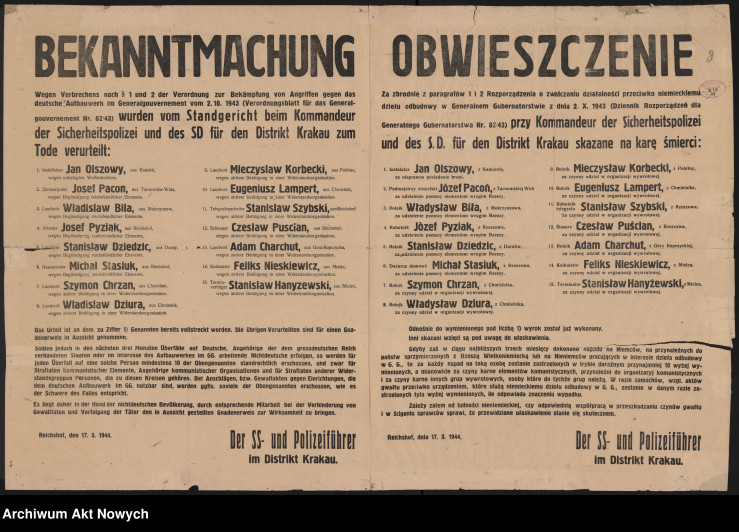
A German poster from March 1944 with information about the death sentence given to Michał Stasiuk and others for helping Jews, “elements hostile to the Reich” (source: Archive of Modern Records, file ref. no. 2/1335/0/8.2/130).
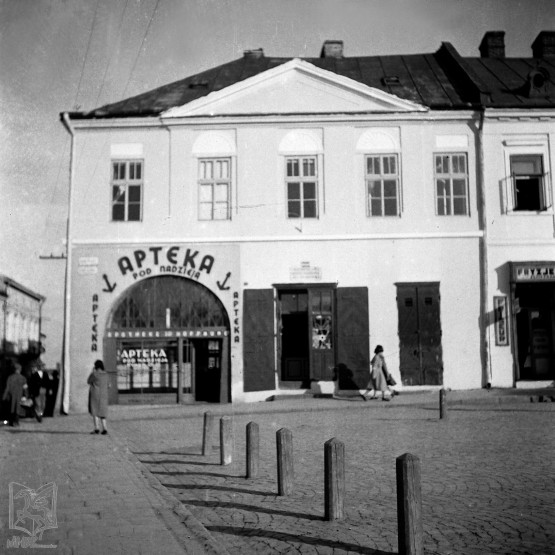
The Rynek 15 tenement house (“Esterka House”, “Schipper House”), under which a Jewish hideout – called a “Bunker” by its tenants – was located during the Holocaust. During the occupation, the building housed the “Pod Nadzieją” Pharmacy (source: public domain).
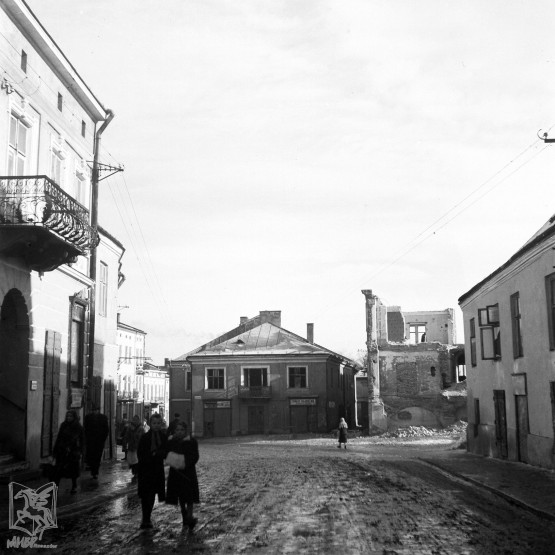
Houses on Mickiewicza Street during demolition (in the center). The exit from the “Bunker” was located beneath (source: public domain).
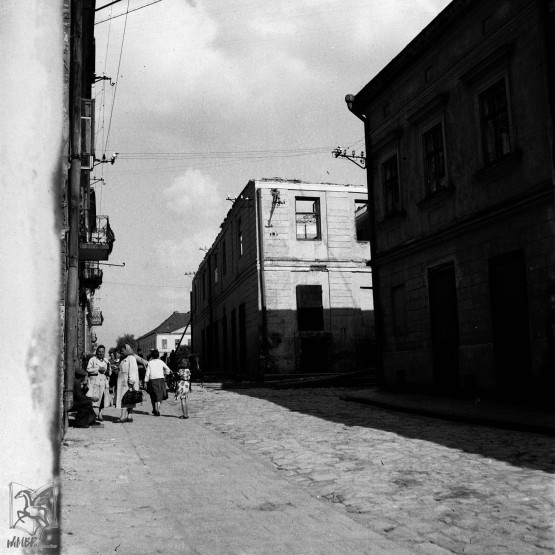
A view from Matejki Street towards the market square. The balconies on the left belonged to the tenement house where Wiktoria and Michał Stasiuk lived. Their son Marian Stasiuk lived with his family in the opposite tenement house. A fragment of the Rynek 15 tenement house, under which the main part of the Jewish hideout was located, can be seen in the background (source: public domain).
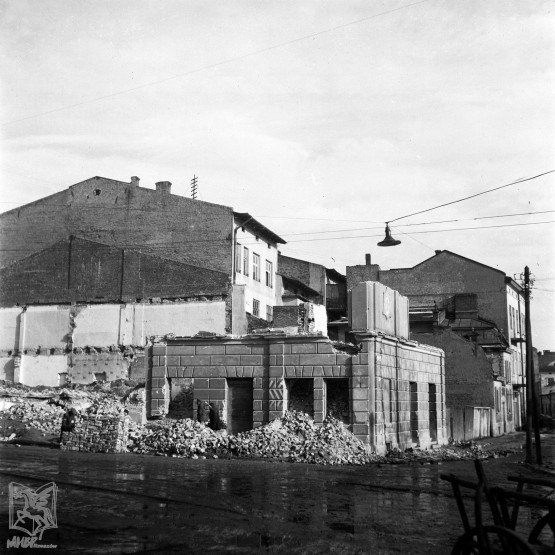
The tenement house at Króla Kazimierza Street 1 during demolition. The Stasiuk family lived in this building until 1941 (source: public domain).
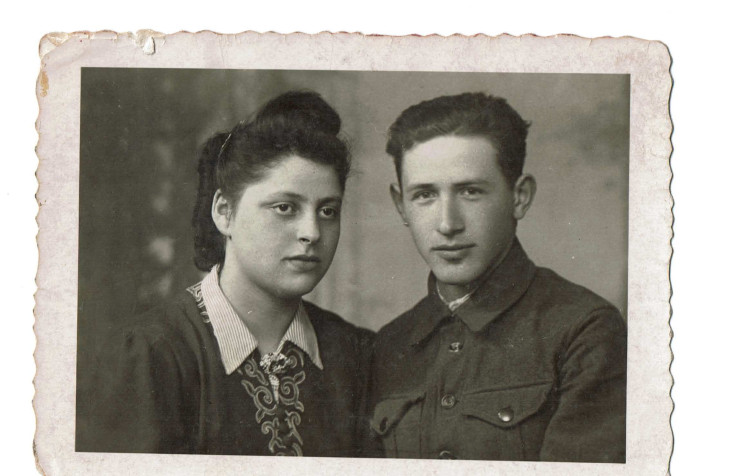
Helena Kramberg, née Ojzerowicz, with her husband Wiliam (Wolf) Kramberg. She was hiding under the market square together with her sister Gusta and father Abraham. After they fled the “Bunker”, they received help from Cecylia and Józef Cisek (source: collection of Arthur (Aaron) Goldman (b. 1912 in Kańczuga) / Historical Institute of Kańczuga).
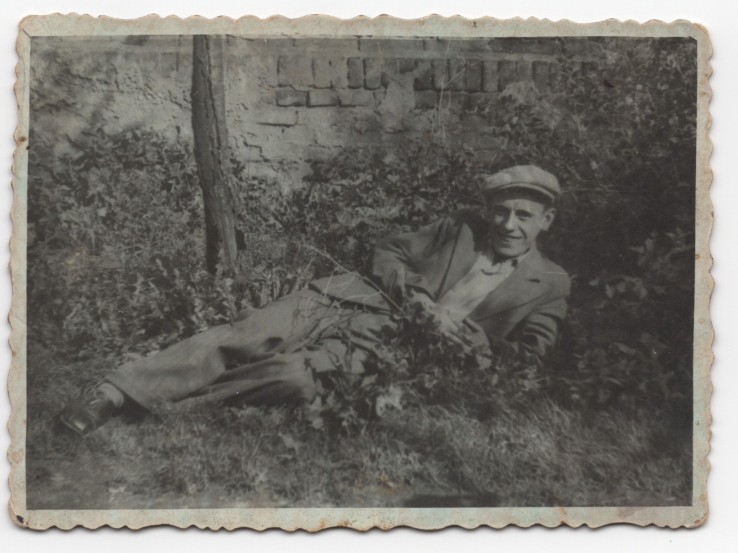
Marian Stasiuk (1918–1985), the son of Wiktoria and Michał. During the occupation, he was assigned to work as a caretaker in the building of the Rzeszów Gestapo. Together with his parents, he engaged in helping Jews (source: collection of the Stasiuk family).
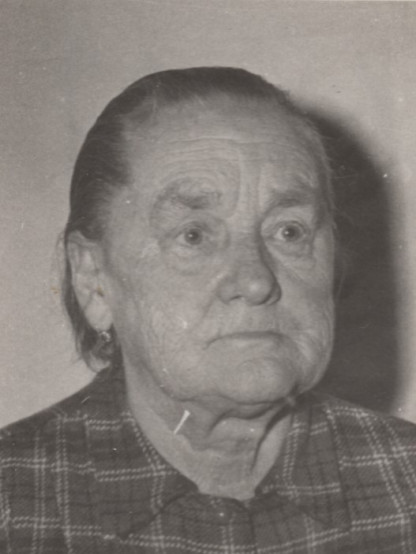
Wiktoria Stasiuk (1890–1962), Michał’s wife, also engaged in helping Jews (source: collection of the Stasiuk family).
COMMEMORATION, Rzeszów, 19 November 2022
On 29 November 2022 in Rzeszów, the Pilecki Institute commemorated Michał Stasiuk, who was murdered by the Germans because – together with his wife Wiktoria and son Michał – he was helping several dozen Jewish fugitives from the Rzeszów ghetto who were hiding in the basements of the Rzeszów market square.
The main organizer was the Pilecki Institute, but the event was co-organized by the Rzeszów City Hall and its institutions: Estrada Rzeszowska and the Rzeszów Basements.
As a prelude to the event, an exhibition devoted to the “Called by Name” was opened in the Culture Square, while on 27 November, the Pilecki Institute – together with the City Hall, the Rzeszów Board of Education, the Rzeszów Basements and Estrada Rzeszowska – presented a broad educational program for the local community, students and teachers.
The commemoration of Michał Stasiuk began with a mass at the St. Adalbert’s and St. Stanislaus’ Church. Due to low temperatures, the official ceremony was held at the city hall, and then the commemorative plaque was unveiled in the “Silent Unseen” Square, followed by wreath laying.
The guests included representatives of the local government, the Jewish community, students and uniformed services, but first and foremost the Family: Anna Stasiuk, the wife of Michał Stasiuk’s grandson, his great-grandson Łukasz Stasiuk and two great-granddaughters, Monika Kowalczyk and Agata Czerniak. Among the guests were also representatives of other “Called by Name” families: Jadwiga Wędrychowicz, a relative of Józef Pruchniewicz from Biecz and Karol Krzyszczuk, a relative of Apolonia Gacoń from Bukowa/Januszkowice.
An extremely moving moment came with the speech of Michał Stasiuk’s great-granddaughter, Agata Czerniak, who saw a link between the situation of Jews during the German occupation and the current fate of Ukrainians in the face of Russian invasion.
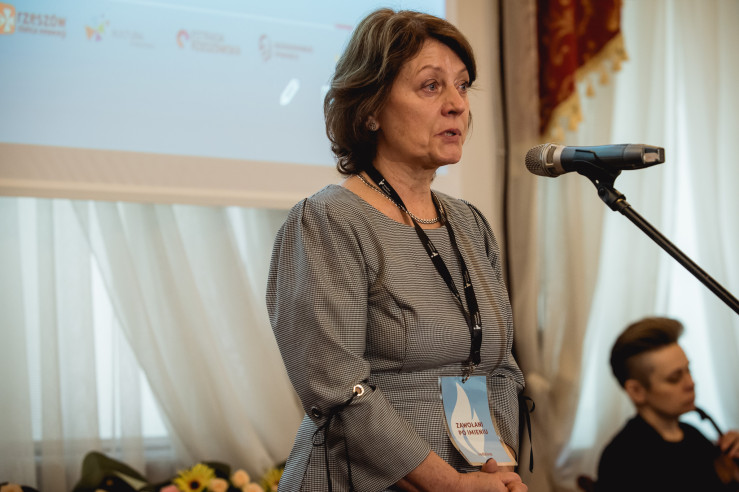
Wiktoria, Michał, Marian, I am calling you by name; together with my entire family, I want to express gratitude that I am your descendant. The past few days were a huge challenge for me and my loved ones. I discovered a truth I never knew about. I have always admired great people, great Poles, but it never occurred to me that such people – people with big hearts – were members of my own family. They helped because they saw the suffering of innocent, defenseless people. Now there is another war, new refugees, new tragedies and new deaths. We invited two women from Ukraine to stay with us at our home. After some time I learned that one of them has Jewish roots. When Mr. Kamil Kopera from the Pilecki Institute called me to tell me about the Program, I couldn’t believe that history has come full circle, because my great-grandfather and grandfather were also helping the Jewish community. I would like to thank the employees of the Pilecki Institute for letting me and my family discover the remains of family members. I am grateful to these strangers who brought back our loves ones, said great-granddaughter of the “called by name” Michał Stasiuk.
Prof. Magdalena Gawin, Director of the Pilecki Institute and, first and foremost, initiator of the “Called by Name” program, highlighted the spiritual dimension of helping others. She also paid homage to the residents of Rzeszów.
Prof. Magdalena Gawin, Director of the Pilecki Institute, initiator of the “Called by Name” program.
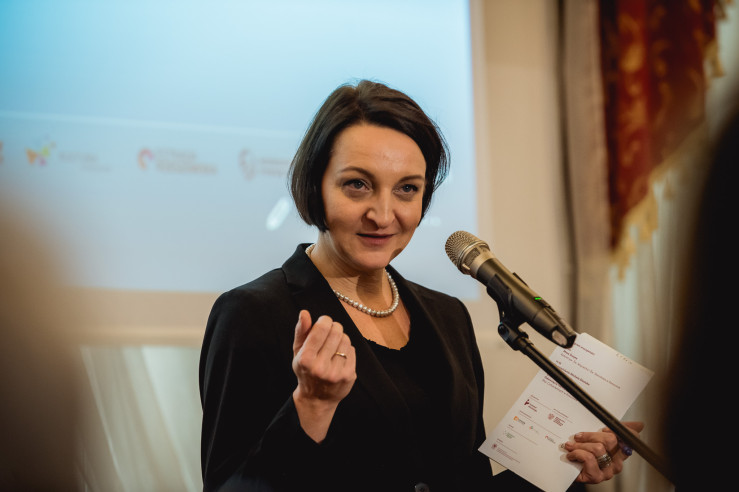
Both the Polish helpers and the hiding Jews often perished – and I wanted people to never doubt that it is worth helping others. Giving your life for another has a deep meaning. We cannot say that these were unsuccessful attempts at rescuing others, because it was so much more – a very important moral testimony for all of us. Rzeszów has recently been named “rescuing city” by President Zelensky: a city with 200,000 residents welcomed 100,000 Ukrainians, and two million refugees passed through the city. We are all proud of you – said Prof. Magdalena Gawin, Director of the Pilecki Institute, initiator of the “Called by Name” program.
Irv Berliner, the son of Natan Berliner, who was hiding in the Rzeszów basements with the help of Michał Stasiuk
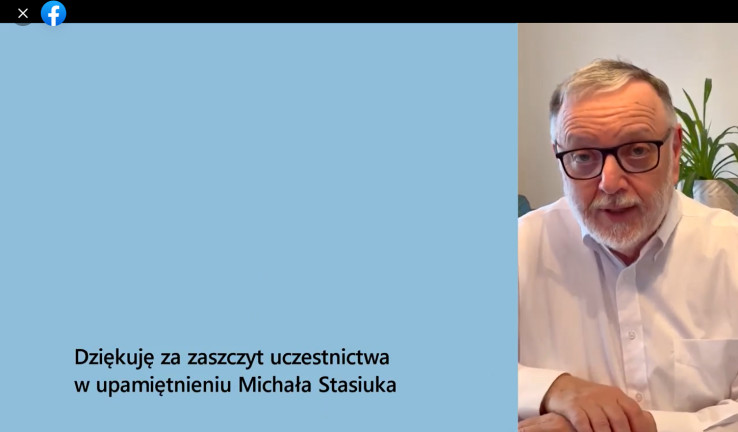
My father didn’t perish thanks to his strong will for survival, but also thanks to Michał Stasiuk, who took the trouble to help others, risking his own life in the process. I am alive today thanks to his aid. I never had the opportunity to thank Mr. Stasiuk or to acknowledge his sacrifice and the sacrifice of others who also should be ‘called by name’, so now I would like to say: thank you, said Irv Berliner – the son of Natan Berliner, who was hiding in the Rzeszów basements with the help of Michał Stasiuk – in a film recording addressed to the participants.
During the ceremony, a letter was read out from Ambassador of Israel to the Republic of Poland Mr. Yacov Livne, who wrote about Michał Stasiuk:
For his heroic actions, for which he paid the utmost price, in 2019 the Yad Vashem Institute awarded Michał Stasiuk – as well as his wife Wiktoria – with the “Righteous Among the Nations” Medal, the highest civilian decoration in Israel.
The Righteous are our common heroes. They have always been, and will always be, our role models: paragons of true humanity and fidelity to moral principles. We owe them respect and memory, which has to be passed on to further generations.
In the Jewish tradition, we say about the deceased: “May their memory be a blessing.” The memory about Michał Stasiuk and his actions will forever be a blessing for our nations.
Next, the commemorative stone dedicated to Michał Stasiuk and the Jewish victims whom he was helping was unveiled in the “Silent Unseen” Square in the presence of the gathered guests.
The commemorative plaque was unveiled jointly by Prof. Magdalena Gawin, Director of the Pilecki Institute and initiator of the “Called by Name” program; Vice-President of Rzeszów Krystyna Stachowska; and representatives of Michał Stasiuk’s family: Mrs. Anna Stasiuk, the wife of Michał Stasiuk’s grandson; Mr. Łukasz Stasiuk, Michał Stasiuk’s great-grandson; Mrs. Monika Kowalczyk, Michał Stasiuk’s great-granddaughter; Mrs. Agata Czerniak, Michał Stasiuk’s great-granddaughter.
A prayer on behalf of the Jewish community was said by Rabbi Refael Popack from the Chabad-Lubavitch movement in Kraków.
Following the ceremony, selected delegations went to the Victims of the Ghetto Square to pay homage to the Jewish residents of Rzeszów who perished during the Holocaust.
